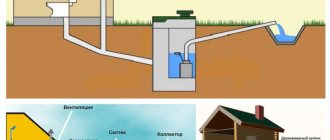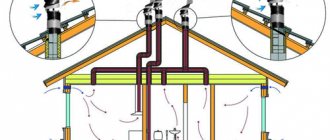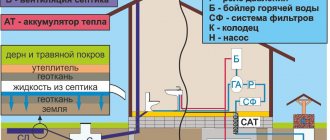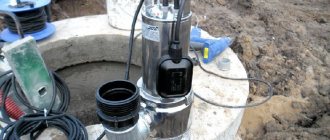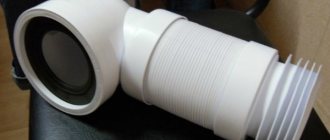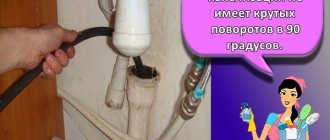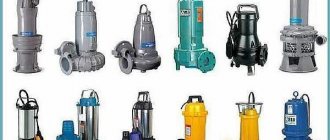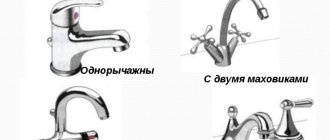Even the most careless homeowner acts quickly and energetically in the event of sewerage problems.
And this is not surprising, because this system very persistently knows how to draw attention to its own problems - the most unpleasant smell helps it in this.
Analysis of drinking water from any sources at gicpv.ru control and testing center.
Only a person completely deprived of the sense of smell can put up with it; everyone else has to roll up their sleeves and immediately get to work. Our article, the topic of which is the smell of sewerage in a private house: causes and elimination, will be a good help in this.
Causes of unpleasant odors
Let’s start our review of the causes of sewer smell in a private home with the most likely ones:
- The water seals were left without water: the direct duty of the water seal is precisely to prevent the penetration of foul-smelling air from the sewer into the room. This device is designed (it can be found under every sanitary fixture) in such a way that it always contains a small portion of water, which acts as a plug. It is clear that in the absence of water, the water seal (also called a siphon) will not be able to perform its function.
- The appearance of leaks at the junctions of various pipeline elements: since wastewater in the sewerage system “travels” by gravity, that is, without excess pressure, all elements of this system are connected in the least reliable way - through a socket. Such a connection may leak under the following circumstances: installation errors, drying out of the rubber sealing element (important for polymer pipelines) and poor water drainage due to blockage or insufficient pipe slope.
- Violation of the integrity of the pipe wall or other element.
Now let's see how we can correct the situation in each specific case.
Replacing pipes is an expensive undertaking, so many people try to save money and carry out all the work themselves. Replacing pipes in an apartment: wiring options, selection and installation of pipes.
Read about how to replace a sewer riser in an apartment building here.
A country house with all communications is the dream of every homeowner. You need to think about laying a sewer system at the construction stage. In this topic https://aquacomm.ru/cancliz/zagorodnyie-doma/avtonomnaya/kak-sdelat-kanalizatsiyu-v-chastnom-dome.html we will look at how sewerage should be arranged in a private house. Pipe layout and waste disposal facilities.
Correct installation
If an unpleasant odor appeared immediately after installing the sewerage system and using it, then there is a high probability that the problem lies in incorrect installation: incorrect calculations were made, an inaccurate diagram was used and an incorrect slope of the pipes.
To be able to identify connection errors that lead to the formation of a stench, you should know the rules and requirements:
- The toilet structure is mounted below all other devices at a separate point.
- The riser should not be narrower than the diameter of the toilet outlet (100 mm). The diameter of other connections is larger than the size of the outlet pipe of the plumbing fixture, and preferably equal to 70 mm.
- The distance of the toilet structure from the riser should not be more than 1 m; other devices can be placed at a distance of no more than 3 m.
- When installation is made to a riser at a distance of more than 3 m, it is made from a pipe of 70 mm or more.
When installing a sewer system, it is better to follow the step-by-step instructions
. The most common mistake is using 900 shaped corners to design turns. The water bounces off in them, and this leads to the rapid formation of blockages. To avoid this, 1350 turns are used, which create a smooth flow.
One of the critical mistakes is failure to comply with standards and requirements when installing a sewerage system.
For example, failure to comply with the pipeline slope level. Such a mistake always leads to a clogged pipeline and an unpleasant odor, and it can only be solved by redoing the entire job, that is, reinstalling the sewer system.
The problem is in the water seal
There are several reasons why the water seal could be left without water:
Drying out
Everything is clear here: if the device is not used for a long time, the water in the siphon dries out.
As soon as it is filled with water again, the unpleasant odor entering the room will stop. The problem of a dry siphon is most typical for private baths and saunas, which are usually used once a week. In such rooms it is recommended to install so-called dry water seals.
In them, the role of a plug is played not by water, but by a light ball or valve, which, if there are drains, float up and open the way for them, and if there are none, they fall onto the saddle and block the hole leading to the sewer.
The only device that cannot be equipped with such a water seal is the toilet.
The appearance of a crack in the siphon body
This is rare, but it happens. We will tell you below how to repair a hole if it is not yet possible to replace the part.
Disruption
Conventional U-shaped siphons are susceptible to failure.
If the pressure inside the sewer pipe is much less than the outside pressure, the water plug from the water seal will be drawn into the system - this is a failure.
The pressure drops in cases where a large amount of water is discharged into the sewer: it fills the entire pipe and moves in it like a piston in a pump.
Most often, a breakdown occurs when the drain tank is emptied.
To compensate for the pressure drop, the sewer risers are “connected” to the atmosphere through a waste pipe, which is discharged to the street. So, if the system is properly configured, there should be no failures. If they are still observed, the reason may be the following:
- The horizontal collector pipe, to which all devices are connected, has insufficient diameter. Typically, the collector is laid to the toilet with a pipe with a diameter of 50 mm. But if too many devices are “hung” on it, the diameter should be increased to 80 or 100 mm. Otherwise, the drains will block the entire cross-section of the pipe and produce a suction effect, which is especially noticeable in polymer pipes with their very smooth walls.
- The toilet is located further than 1 m from the riser: a distance of 1 m is the maximum permissible - this is a requirement of building codes. Otherwise, breakdowns will occur quite often. As already mentioned, a substantial portion of water from the cistern moves in the pipe like a piston. The greater the distance such a “piston” travels to the riser with ventilation, the more the pressure in the pipe has time to drop.
- The drain pipe turned out to be clogged.
We'll talk about this in the next section.
If possible, install so-called instead of U-shaped siphons. bottle ones (similar in design to a hookah) - it’s impossible to pick them off.
Ventilation problem
Clogging of a drain pipe with debris occurs quite rarely and mainly in cases where the pipe is laid out horizontally (through the wall, not onto the roof) and covered with a decorative rosette.
Most often, the cross-section of the ventilation pipe decreases due to icing: it is obvious that the sewer contains a huge amount of water vapor, and when it enters the outer part of the ventilation pipe, it settles on its walls in the form of condensation.
If it is frosty outside, the condensation will immediately turn into an ice crust, which will gradually increase.
To avoid icing, you need to do the following:
- Insulate the pipe.
- Remove the cap from its head if one was installed by mistake. The installation of a protective cap is prohibited by building codes, since it is on it that an ice plug begins to form in winter.
To check the functionality of the fan pipe, you need to open the inspection at its base (installed between this pipe and the riser) and bring a piece of paper to the hole: if the pipe is clean, the air draft will attract the sheet to the inspection. Otherwise, the fan pipe will have to be cleaned.
Sealing cracks in sewer pipes
It is clear that a leaky pipe or other element needs to be replaced, but the following can be done as temporary measures:
If the breakdown has a round shape
You can offer several “amateur” options:
- Hammer a short, conical-shaped wooden plug into the hole (the long one will collect dirt).
- Wrap the damaged area with gauze or a bandage and then impregnate them with epoxy resin.
- Wrap the area with the fistula with a wide rubber band (with tension), and then pull it tightly with several turns of wire.
“Proper” repair involves installing a clamp with a rubber gasket or a repair coupling.
If the hole looks like a crack
Icing, which was described above, leads to the appearance of such defects. They can also be caused by pipe defects.
If the crack is not through, it must be carefully widened, cleaned, treated with a degreaser and, after drying, filled with sewer pipe sealant.
Through cracks are reliably sealed by “cold welding”, also applied to a degreased surface.
The appearance of leaks
If drains begin to leak at the junction of elements, the fastest way to correct the situation is with the help of a special sealing tape. It appeared relatively recently, consists mostly of polyethylene and is intended to solve precisely this kind of problem. Sealing tape is used as follows:
- Dust and dirt are washed off from the surface of the pipes at the junction, and then dried.
- Trying to pull it tighter, the tape is wound around the joint and adjacent sections of pipes. It should lie without wrinkles or folds. Each turn overlaps the previous one by half the width.
- Having passed the joint in one direction, they begin to move in the opposite direction, so that the tape is ultimately laid in two layers.
- If the joint to be sealed is located outdoors, the tape must be protected from UV radiation with an additional coating or casing.
One of the reasons for leaks, as already mentioned, is the loss of elasticity of the sealing rubber due to natural aging. In this case, it is recommended to additionally coat the joints with silicone sealant for sewer pipes. This is especially true for pipelines laid in a hidden way, for example, from a drain built into the floor.
It is better to use a neutral sealant, since an acidic one (it is cheaper) can have a negative effect on some materials.
Another common cause of leaks is stagnation of water in the pipe due to a blockage.
Leaks – we eliminate microcracks and leaks
Pipes often leak at the joints, and an unpleasant odor spreads into the room. We eliminate leaks depending on the cause of the leak. If the pipes have shifted, we restore the correct position. On plastic pipes, for various reasons, rubber sealing rings fail, which we replace or treat the joints with sealant. On cast iron joints we also use silicone sealant or, if they are located horizontally, cement mortar.
To eliminate a leak in a plastic pipe, drain the water and dry it. We prepare a patch from a pipe of the same diameter: cut a piece of the required length, cut it lengthwise. Near the place of the crack or rupture, apply a layer of glue suitable for this material. Apply the patch and press it. If a crack is found at the joint, apply a layer of silicone, oil paint, and glue to it. We wrap it with tow, a bandage, and apply a water-repellent layer on top.
We repair cracks in cast iron pipes using epoxy glue or cold welding. We wrap the area around the crack with a bandage soaked in epoxy and fix it. You can also use a piece of thin rubber, which we wrap around the leak area and secure with wire or a clamp. The absence of high pressure will ensure reliable sealing even in such simple ways.
How to get rid of a blockage?
How to remove the smell of sewerage in a private house and get rid of the blockage?
If there is no time to take serious measures, you can try to push through the blockage by pumping it with a plunger.
A more effective tool is a special cable with a handle similar to the handle of a brace.
When feeding the cable into the sewer, the rotation helps it go through bends and turns.
Today there are effective chemicals that can corrode dirt plugs. The most popular are the compositions of the “Mole” and “Tiret” brands.
In the pipe coming from the kitchen sink, blockages can form due to grease accumulating on the walls. To cope with this problem, you can pass a couple of buckets of hot water through the pipe, in which you must first dissolve a pack of soda.
Odors in the washing machine and how to deal with them
The cause of an unpleasant odor in the bathroom or kitchen may be the washing machine. Mold often develops on the powder tray and rubber seal. This occurs during frequent washing at low temperatures. In order to avoid this, the machine must be washed and wiped dry after each wash. Since fungal spores do not tolerate hot water, the maximum temperature should be used once a month.
From time to time you need to check the drain hose and filter, which is located on the drain pump. Debris and dirt accumulate in these places. Remove them with washing powder or a special product. To do this you need:
- add powder;
- start washing at a temperature of 90C (you cannot load the machine!);
- Wash the inside of the machine, carefully removing dirt under all rubber parts.
Features of eliminating sewer odors in a private home
It should be noted that in some cases, the sewage system may not be involved in the appearance of an unpleasant odor, although it will be very similar to “sewage”. Here are some common reasons:
- dirt accumulating in the pump and drain tract of the washing machine;
- sludge on the walls of the cistern;
- water getting between the bathtub and the acrylic insert.
The presence of places with constant dampness, for example, under a bathtub, if the seam between it and the wall is poorly sealed, will also lead to the appearance of an unpleasant odor.
The most effective way to get rid of blockages in pipes is a plumbing cable for clearing drains. Read the article on how to use it correctly.
Why you need an air valve for sewerage and whether it is necessary to install it, you will learn in this topic.
Prevention
An important preventative measure is to reduce the risk of blockages in the drainage system. To do this, it is necessary to prevent hair, animal hair, lint, and food debris from entering through the drain hole. It is not recommended to flush solid objects, including food, down the toilet. The same measure serves to prevent the formation of chips and cracks.
It is recommended to fix the problem before it occurs. Poor drainage of water will indicate the formation of a blockage. The liquid will gradually begin to accumulate and create unpleasant odors. If you remove the blockage in the drainage system in a timely manner, which people do in most cases, then an unpleasant odor will not appear.
